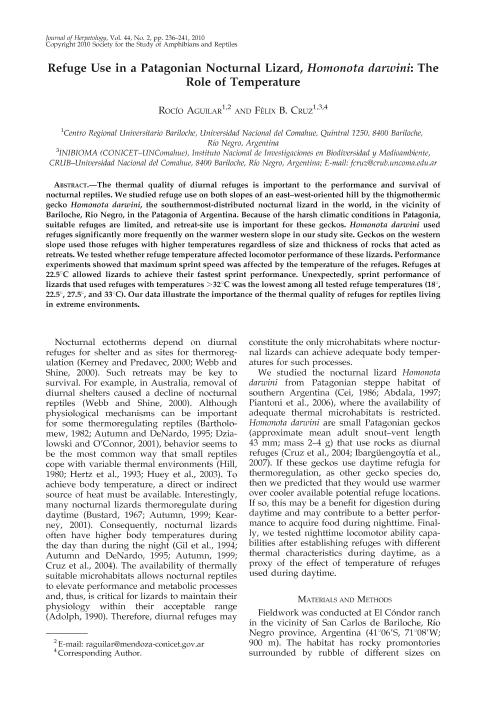Artículo
Refuge use in a patagonian nocturnal lizard, homonota darwini: The role of temperature
Fecha de publicación:
06/2010
Editorial:
Society for the Study of Amphibians and Reptiles
Revista:
Journal of Herpetology
ISSN:
0022-1511
Idioma:
Inglés
Tipo de recurso:
Artículo publicado
Clasificación temática:
Resumen
The thermal quality of diurnal refuges is important to the performance and survival of nocturnal reptiles. We studied refuge use on both slopes of an east–west-oriented hill by the thigmothermic gecko Homonota darwini, the southernmost-distributed nocturnal lizard in the world, in the vicinity of Bariloche, Rio Negro, in the Patagonia of Argentina. Because of the harsh climatic conditions in Patagonia, suitable refuges are limited, and retreat-site use is important for these geckos. Homonota darwini used refuges significantly more frequently on the warmer western slope in our study site. Geckos on the western slope used those refuges with higher temperatures regardless of size and thickness of rocks that acted as retreats. We tested whether refuge temperature affected locomotor performance of these lizards. Performance experiments showed that maximum sprint speed was affected by the temperature of the refuges. Refuges at 22.5uC allowed lizards to achieve their fastest sprint performance. Unexpectedly, sprint performance of lizards that used refuges with temperatures .32uC was the lowest among all tested refuge temperatures (18u, 22.5u, 27.5u, and 33uC). Our data illustrate the importance of the thermal quality of refuges for reptiles living in extreme environments.
Palabras clave:
Homonota
,
Thermoregulation
,
Refuge Selection
Archivos asociados
Licencia
Identificadores
Colecciones
Articulos(IADIZA)
Articulos de INST. ARG DE INVEST. DE LAS ZONAS ARIDAS
Articulos de INST. ARG DE INVEST. DE LAS ZONAS ARIDAS
Citación
Aguilar, Rocío; Cruz, Felix Benjamin; Refuge use in a patagonian nocturnal lizard, homonota darwini: The role of temperature; Society for the Study of Amphibians and Reptiles; Journal of Herpetology; 44; 2; 6-2010; 236-241
Compartir
Altmétricas




